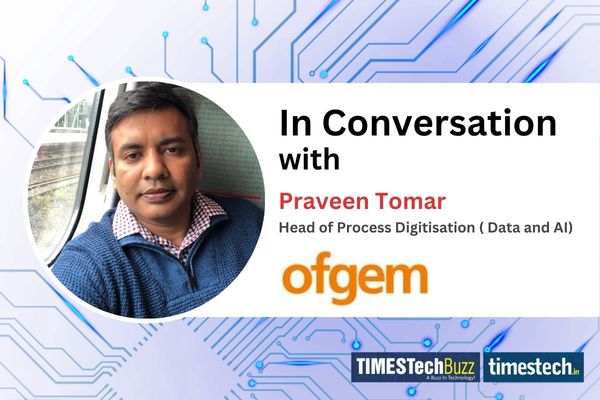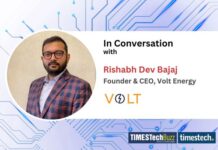In an exclusive interview, Praveen Tomar, Head of Process Digitalisation (Data and AI) at Ofgem, discusses his patented AI-powered fake news detection tool. Aiming for 98% accuracy, this innovative solution combines advanced machine learning with human oversight to combat misinformation, offering a cost-effective and accessible resource for media outlets, government agencies, and the public.
Read the full interview here:
TimesTech: How can fake news and disinformation impact us, both individually and as a society?
Praveen: Fake news and disinformation are intentionally false or misleading pieces of information spread with malicious intent to deceive or manipulate. They have the potential to erode public trust, polarise societies, and disrupt democratic processes. Individually, they can lead to ill-informed decisions, propagate fear, or damage reputations. As a society, they undermine democratic institutions, create social divisions, and may even incite violence. According to sources such as the Harvard Kennedy School’s Shorenstein Centre and the Pew Research Centre, the rapid dissemination of such content via social media exacerbates these impacts, underscoring the importance of fostering media literacy and cultivating fact-checking habits.
Some recent examples are:
1. Southport Riots in the UK:
False Identity Claims: After a tragic stabbing incident in Southport where three children were killed and several others injured, misinformation spread rapidly on social media. A false name was attributed to the 17-year-old suspect accused of the crime.
2. India’s General Election – Reservation Removal Fake Video:
Amit Shah’s Doctored Video: During India’s 2024 general election, a doctored video of Home Minister Amit Shah circulated online. The manipulated video falsely claimed
3. Misinformation on EVMs: Another prevalent misinformation theme during the election was related to Electronic Voting Machines (EVMs). A video showing a polling agent pressing the EVM button multiple times for the BJP candidate during a mock poll was shared with misleading claims that it occurred during actual voting in the second phase of the Lok Sabha election.
TimesTech: Please tell us more about your potential solution/patent design to deal with fake news?
Praveen: My recent patent, granted by the UK Intellectual Property Office, is for an ‘AI-Powered Fake News Detection Digital Tool.’ This tool is based on a large-scale machine learning model that incorporates human input, allowing journalists to provide feedback and enhance its accuracy over time. Currently, the proof of concept for this product is under development. It is designed to collect news data feeds from various national and international news aggregators, as well as social media platforms such as Facebook, Twitter, YouTube, Instagram, and others. This tool is highly robust and can predict with up to 98% accuracy.
The impact of this AI-powered tool on media outlets and society could be significant. For media outlets, it offers a powerful resource to ensure the accuracy and reliability of their content, reducing the spread of misinformation and protecting their credibility. This tool could also streamline the verification process, allowing journalists to focus on in-depth reporting rather than fact-checking. On a societal level, the tool could help restore public trust in the media, reduce polarization, and foster a more informed and cohesive public discourse by mitigating the spread of disinformation.
Details of Patent design – Design number: 6373994 and Grant date: 02 July 2024.
Link: https://www.registered-design.service.gov.uk/find/6373994
TimesTech: What is the unique proposition you have in your solution to fight with fake news and disinformation?
Praveen: The unique proposition of my digital tool lies in its ability to allow all journalists or special groups of people (authorised) to provide real-time feedback on the output, ensuring it is constantly being trained and supervised through a human-in-the-loop approach in machine learning. Additionally, this tool will be cost-effective and accessible to anyone who wishes to verify the authenticity of news, making it a valuable resource for individuals, media outlets, and society as a whole. This unique combination of ongoing human input and affordability sets it apart from other solutions in the market.
TimesTech: What is the accuracy percentage or reliability in identifying fake news using your online tool solution?
Praveen: As I mentioned earlier, we are targeting for 98% and above accuracy to reach within first few months of launch.
TimesTech: What other popular solutions are available in the market to deal with the issue of fake news, and how reliable are they?
Praveen: Fake news detection tools vary in their approach. Some focus on fact-checking specific claims, while others analyse the credibility of sources or detect bots and misinformation spread. Respected tools like Snopes, FactCheck.org, and PolitiFact thoroughly fact-check political content. Hoaxy and Botometer track information spread and identify bots. NewsGuard rates news sources based on journalistic standards. Google Fact Check and Logically combine AI and human oversight. Media Bias/Fact Check helps understand source bias. Combining these tools enhances reliability.
TimesTech: Is it going to be cost-effective, and who are the potential users/buyers/subscribers for it?
Praveen: My online tool, an AI-powered fake news detection tool, is designed to be highly cost-effective, user-friendly, and accessible to meet diverse user needs. Some potential users of this online tool/platform are:
- Journalists and News Organizations: To verify the accuracy of information before publication and maintain credibility.
- Educational Institutions: Schools, colleges, and universities can use the tool to teach media literacy and critical thinking.
- Government Agencies: For monitoring and combating the spread of misinformation that could affect public policy or safety.
- Businesses and Corporations: To protect their brand reputation by ensuring that information about their company is accurate.
- Social Media Platforms: To integrate the tool into their systems to flag or filter out false information.
- General Public: Individuals seeking to verify the authenticity of news and avoid being misled by misinformation.
- Non-profit Organizations: Focused on combating misinformation and promoting truthful communication.
- Fact-checking Organizations: To enhance their capabilities with more efficient and accurate detection methods.
TimesTech: What is the role of technology in detecting fake news?
Praveen: Technology plays a vital role in detecting and preventing the spread of fake news and misinformation. Advanced tools, including machine learning, natural language processing (NLP), and AI algorithms, are used. Machine learning models like deep neural networks, transformer models (such as BERT or GPT), and support vector machines (SVMs) analyse large data volumes to identify patterns of misinformation. NLP helps understand context and sentiment, while AI tools cross-reference information from multiple sources for verification. Blockchain ensures secure data verification, and quantum computing holds promise for faster, more accurate detection. These technologies collectively enhance real-time verification, flag false content, and promote an informed society.














